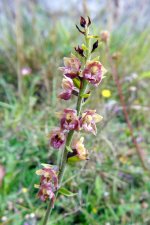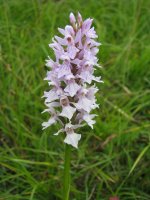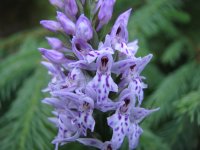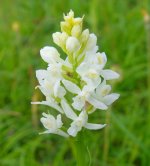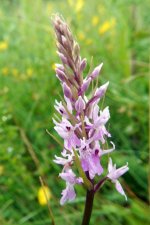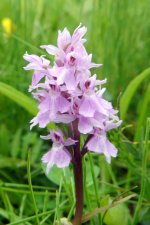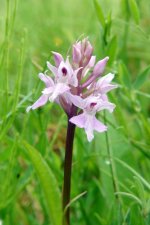-
Welcome to BirdForum, the internet's largest birding community with thousands of members from all over the world. The forums are dedicated to wild birds, birding, binoculars and equipment and all that goes with it.
Please register for an account to take part in the discussions in the forum, post your pictures in the gallery and more.
You are using an out of date browser. It may not display this or other websites correctly.
You should upgrade or use an alternative browser.
You should upgrade or use an alternative browser.
2017 UK orchids (2 Viewers)
- Thread starter muba
- Start date
More options
Who Replied?rmielcarek
Well-known member
Why not X Dactylodenia st-quinitinii, the hybrid between Common Spotted and Chalk Fragrant. This plant was shown to me by heakl (remember him from WAB?) on 6th July 2015 on Sheepscombe Common and has many of the same features as your plant. This one had a strong fragrance, did yours?
Jeff Hodgson
Jeff
notice how the Sheepscombe hybrids have quite a long curved spur, showing the gymnadenia influence. I don't see this in the East Tilbury plant, personally I'd put it down as a Common Spotted with and odd shaped lip.
At least it's nice to have something to discuss on here, it's been pretty quiet lately. Where does all the orchid discussion take place nowadays?
Rich M
leptochila
Well-known member
At least it's nice to have something to discuss on here, it's been pretty quiet lately. Where does all the orchid discussion take place nowadays?
Rich M
It's moved rapidly to Facebook and Twitter which now throws up much more discussion and finds.
For instance - did you know Serapias lingua has been found in Essex?
Both are far easier and quicker for uploading images and commenting plus specific groups can be created such as 'Native British Orchids' and so on which serve the same purpose as these threads.
The one advantage of these forums, however, is that the posts are recorded in chronological order which isn't the case on Facebook because posts seem to be sorted by popularity.
Mike
muba
Well-known member
It's moved rapidly to Facebook and Twitter which now throws up much more discussion and finds.
For instance - did you know Serapias lingua has been found in Essex?
Both are far easier and quicker for uploading images and commenting plus specific groups can be created such as 'Native British Orchids' and so on which serve the same purpose as these threads.
The one advantage of these forums, however, is that the posts are recorded in chronological order which isn't the case on Facebook because posts seem to be sorted by popularity.
Mike
Facebook and especially Twitter are very much what's in the news now. A week old post is unlikely to be revisited. This forum is much more suited for serios discussion.
Indeed good to have something to discuss, Rich.
You mention the long spur on my plant (more correctly heakl’s), is it not possible for a hybrid to have variation too, that is to say, need this hybrid invariably have a long spur, or might it lean towards the CSO in that respect.
I do wish I knew more about it.
Jeff
You mention the long spur on my plant (more correctly heakl’s), is it not possible for a hybrid to have variation too, that is to say, need this hybrid invariably have a long spur, or might it lean towards the CSO in that respect.
I do wish I knew more about it.
Jeff
rmielcarek
Well-known member
Indeed good to have something to discuss, Rich.
You mention the long spur on my plant (more correctly heakl’s), is it not possible for a hybrid to have variation too, that is to say, need this hybrid invariably have a long spur, or might it lean towards the CSO in that respect.
I do wish I knew more about it.
Jeff
Unfortunately Jeff most of the field guides ignore hybrids, although one that does cover them is the Lang 'Orchids of Britain' from 1980. That says that CSO x CF has 'spur very long and decurved, flowers scented'
People have mentioned that maybe in this case the parentage is reversed so giving a different appearance. I'm not convinced by that argument.
As for variation in hybrids then yes there probably is, almost certainly,but I'm not sure anyone really knows. However to give you a couple of examples. Not long ago there was an article in the HOS journal about Bee x Fly hybrids that argued the case for a particular plant being the reverse parentage because the plant covered looked somewhat different from the others at the site. However, unknown to the author, the plant in question had been DNA tested and was the same parentage as the others, it just looks different. Another example is our local epipactis hybrids. Four plants were DNA tested and all found to have E. purpurata as the maternal parent and yet all four look subtly different, and one of them extremely so.
Mike, is you new book going to cover hybrids?
One book that does cover hybrids is the new BSBI Hybrid Atlas but I haven't got a copy. If anyone has a copy maybe they could let us know what it says?
Rich
Last edited:
rmielcarek
Well-known member
It's moved rapidly to Facebook and Twitter which now throws up much more discussion and finds.
For instance - did you know Serapias lingua has been found in Essex?
Both are far easier and quicker for uploading images and commenting plus specific groups can be created such as 'Native British Orchids' and so on which serve the same purpose as these threads.
The one advantage of these forums, however, is that the posts are recorded in chronological order which isn't the case on Facebook because posts seem to be sorted by popularity.
Mike
Hi Mike
yes I had heard about the Serapias, isn't it a private site or something? I also saw something about a Fragrant x Pyramidal in Wilts, was that confirmed?
I'll PM you about what groups I need to join on Facebook to see these discussions. Horror of horrors I've just set up a Facebook account.
Rich
Why not X Dactylodenia st-quinitinii, the hybrid between Common Spotted and Chalk Fragrant. This plant was shown to me by heakl (remember him from WAB?) on 6th July 2015 on Sheepscombe Common and has many of the same features as your plant. This one had a strong fragrance, did yours?
Jeff Hodgson
Couldn't say about the fragrance, it was a tiny plant and my nose was bunged up!
I've never seen CSO x CFO hybrid in the field but have to admit none of the photos I've seen on line looked much like this plant.
Interestingly this HSO x HFO isnt so different
http://www.hardyorchidsociety.org.uk/hos 1012/species arcive/borxmac1.htm
Two things against it being a 'pure' CSO
1) Totally unspotted leaves
2) It's only just starting to flower and all the CSOs in the area were either going over or over
This plant was shown to me by heakl (remember him from WAB?) on 6th July 2015 on Sheepscombe Common and has many of the same features as your plant.
Incidentally where roughly on Sheepscombe Common was Heakl's hybrid? It's close to home, in fact I was there on Sunday, so would like to look for it this weekend. Was it on the Common itself or St Georges Field?
Btw, for those interested I could see no sign of flowering Red Helleborines at the Glos site on Sunday. Just two 'blind' but reasonably healthy plants near the lower fence.
rmielcarek
Well-known member
Interestingly this HSO x HFO isnt so different
http://www.hardyorchidsociety.org.uk/hos 1012/species arcive/borxmac1.htm
But note how the caption talks about the long curved spur, which your plant seems to lack.
Try the Common, there are normally a few hybrids scattered about. From a distance they look similar to Fragrants but when you are closer you can see the lip is marked.
Rich M
Hi FGRS, the hybrid was towards the top of the slope as you walk up the common from behind the pub to the cricket field. It was just to the right of the path that leads to the bend in the track where it leads into the cricket field itself. Vague, I know, but hope it helps
Jeff Hodgson
Jeff Hodgson
rmielcarek
Well-known member
Couldn't say about the fragrance, it was a tiny plant and my nose was bunged up!
I've never seen CSO x CFO hybrid in the field but have to admit none of the photos I've seen on line looked much like this plant.
Interestingly this HSO x HFO isnt so different
http://www.hardyorchidsociety.org.uk/hos 1012/species arcive/borxmac1.htm
Two things against it being a 'pure' CSO
1) Totally unspotted leaves
2) It's only just starting to flower and all the CSOs in the area were either going over or over
One further question Simon, are there any Fragrants at the site?
CSO can occasionally have quite odd lip shapes, I've attached a couple of examples.
Rich M
Attachments
muba
Well-known member
Lip colour and pattern of CSOs also seems to be throwing up some slightly unusual plants. I jumped (not literally) on these three as potential hybrids while looking at a patch with many CSO MFO and PO all in flower.
Attachments
One further question Simon, are there any Fragrants at the site?
CSO can occasionally have quite odd lip shapes, I've attached a couple of examples.
Rich M
Yes there were 48 CFO this year apparently but they'd gone over before my visit. It's the only CFO site in Essex and I guess they've probably come across the river from Kent. Also the only Essex site for EMO.
General consensus from the County Recorder, E Tilbury Warden and Prof Richard Bateman is mutant CSO.
rmielcarek
Well-known member
Can anyone pm me with pointers as to where to look for DRH (and others) at Hutton Roof please?
Looks worthy of a visit but a long round trip for me, and quite an area to cover. I would not like to go there and come back empty handed
thanks, Steve
I tried to PM you Steve but your mailbox is overflowing. Anyway contact Bryan Yorke, he's the Hutton Roof man, and very helpful he is. His blog is at
http://arnsidesilverdale.blogspot.co.uk/
Rich M
Gareth Stamp
Well-known member
Irish lady's tresses
Hello All,
I was thinking of planning a trip to see irish lady's tress in Ireland. I would really appreciate any advice on which region would be best to target. Its a long way to go to not be able to find them.
Thanks
Gareth
Hello All,
I was thinking of planning a trip to see irish lady's tress in Ireland. I would really appreciate any advice on which region would be best to target. Its a long way to go to not be able to find them.
Thanks
Gareth
leptochila
Well-known member
Mike, is you new book going to cover hybrids?
One book that does cover hybrids is the new BSBI Hybrid Atlas but I haven't got a copy. If anyone has a copy maybe they could let us know what it says?
Hi Rich
Yes, we will be covering some of the hybrids though unlikely to cover all of the myriad of Dactylorhiza hybrids for obvious reasons.
At a site I know in Surrey there are a range of different chalk fragrant x common spotted hybrids and all of them look very different indicating lots of separate hybridisation events with different parents (obviously common spotted orchids vary greatly in appearance and so do their hybrids).
We've got a copy of the Hybrid Flora here Rich - would you like me to photocopy the orchid bits? There're quite a few!
Mike
rmielcarek
Well-known member
Hi Rich
Yes, we will be covering some of the hybrids though unlikely to cover all of the myriad of Dactylorhiza hybrids for obvious reasons.
At a site I know in Surrey there are a range of different chalk fragrant x common spotted hybrids and all of them look very different indicating lots of separate hybridisation events with different parents (obviously common spotted orchids vary greatly in appearance and so do their hybrids).
Mike
I was going to mention the variation in CF x CSO. At Sheepscombe I've seen them in two different areas and they both looked different.
When is the book due? Looking forward to it.
Rich
Similar threads
- Replies
- 100
- Views
- 4K
Users who are viewing this thread
Total: 3 (members: 0, guests: 3)




